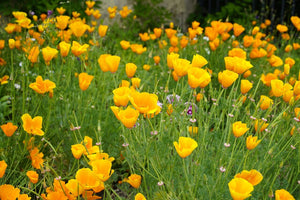Tender Loving Care: How to Protect Your Plants from Frost and Cold
Seasonal gardeningSuccessful gardeners know they need to pay attention to the weather. When the forecast calls for an overnight frost, what can you do to protect your garden? We'll explain the different methods to protect your plants in cold weather.

Deciding when to plant your garden can be a tricky business. Even when you’ve planned ahead, sometimes there’s a cold snap that comes late in the spring and takes everyone by surprise.
Plants you’ve painstakingly grown from seed and hardened off carefully can be endangered by cold temperatures and frost.
Similarly, in the autumn, your harvest season can be interrupted by an unseasonal freeze.

How to Protect Plants From Frost
What can you do to prevent cold damage to your tender plants and keep them healthy?
Fortunately, there are things you can do to protect your outdoor plants when there are short cold spells.
Tender, Hardy, & Semi-Hardy Plants
First, you need to know which plants can handle a cold snap and which ones are frost tolerant.
If your plants are tender, that means they're sensitive to freezing temperatures. A cold snap can injure a tender plant. These are the ones that you want to take the most care of and protect.
If your plants are semi-hardy or hardy, they have some resistance to the cold and you don’t have to worry quite as much. However, some hardy plants can still be affected by cold temperatures by slowing their growth, especially as young plants. If that’s the case with your seedlings, you may still decide to protect them as if they were tender. Mature plants are usually more frost resistant than tender seedlings.
Protecting Container Gardens
If you’re growing a container garden, bring your plants indoors or move them to a sheltered spot to weather out the cold snap. If you don’t have the space to do this, then move your containers together to a sheltered spot near the house. You may also wrap the pots with blankets or plastic to insulate them from the worst of the cold. Container plants are actually much more susceptible to cold damage because they don’t have the protection of the ground to keep their roots warm.
Watering for Cold Protection
To protect your plants from cold weather or a freeze, water thoroughly the day before the freeze. This might be surprising, but wet soil holds the heat better than dry soil and will help to absorb the radiant heat of the day. Skip this step for your succulents, which are more likely to be damaged if they are plump with water.
Mulch for Cold Protection
Mulch around the base of the plants heavily to help the soil you just watered retain its warmth. If your soil drains too quickly, this keeps the soil moist as well as provides a layer of insulation.
You can completely cover small plants with mulch to protect them. Use a lightweight mulch such as pine needles or straw. Be sure to uncover them in the daytime and when all danger of frost has passed.

Cover Overnight
Cover your plants to protect them overnight. You can do this with bed linens, drop cloths, blankets, or plastic sheets.
When using frost blankets and covers on plants, there are a few crucial do's and don'ts to successfully protect them from the cold.
First, breathable fabrics are better than plastic. You can use bed sheets and lightweight fleece blankets. Take care to keep plastic from touching the leaves of plants so that the plastic and leaves don’t freeze together and cause damage to the plant. Hoops, tomato cages, and other tall structures can help hold frost blankets over the plants and not weigh them down.
Next, anchor the cover carefully so it doesn’t move around in the wind and harm your plants. Check for drafts or places the cold could seep in.
And finally, just like with mulching small plants, make sure you remove the cover during the daytime. This will allow the plants to warm up in the sunshine and prevent the plants from overheating.
Keep An Eye on the Weather
Of course, all of these steps require you to pay attention to the weather conditions during the changing seasons. We humans live in climate-controlled houses that always stay in a fairly consistent temperature range, and we can sometimes be a little bit oblivious to the weather. Stay on top of the weather. If you’re forgetful, it’s fairly easy to set up an alert to email you or text you in case of freezing temperatures. A little bit of proactivity goes a long way!

Cold Snap FAQs
Will a cardboard box protect plants from frost?
Yes! A cardboard box will help trap the warmth and keep frost off your plants. You may need to put a rock on top to keep it from blowing in the wind. Remove the box when it starts warming up.
At what temperature should I cover my plants?
Some plants need to be covered when temperatures drop below 40ºF. Other plants, such as cabbage, kale, and broccoli, can tolerate colder temperatures. You can check our growing guides in our Planter's Library for specific information.
Can tomato plants survive frost?
Unfortunately, tomatoes are a warm-weather crop. They don't grow well in temperatures below 50ºF, and they will die off when temperatures drop below 35ºF.
When a cold snap threatens, it's nice to know there are ways to protect your plants from the frost and cold. Whether it's small seedlings in the spring or your fall crops, you can water, mulch, and cover them to keep them growing.
Written by Teresa Chandler
Resources:
Winter Plant Protection - IFAS Extension
Five Ways to Protect Plants from Dipping Temperatures - USU Extension
Protecting Plants from Cold Temperatures - Mississippi State University Extension
Brrrr! How to Protect Plants from Frost or Freeze - IFAS Extension






Leave a comment